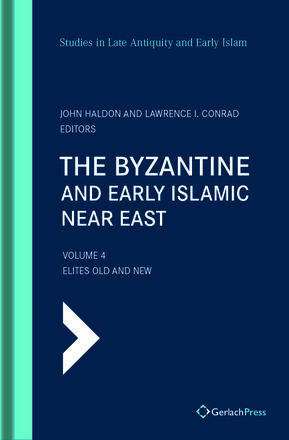John Haldon, Lawrence I. Conrad (eds.)

The Byzantine and Early Islamic Near East
Volume 4: Elites Old and New
Editors: John Haldon, Lawrence I. Conrad
Gerlach Press
Language: English
1. Edition (2021)
Hardcover, xi, 428 pages
HC ISBN 9783959940900
Availability: in print
125.00 € (excl. VAT)
Add to Shopping Cart

Also available as eBook through our vendors
JSTOR, Ebsco, Proquest & Cambridge Core
Format: ePDF
eBook ISBN 9783959940917
Access via JSTOR
> Table of Contents for this book (pdf)
> Bibliographic Data: https://d-nb.info/1217861041 🔗
A collection of critical analyses of the structure, historical development, and composition of the elite strata of late Roman, Byzantine, and early Islamic societies in the eastern Mediterranean basin. Culture change, economic foundations, political roles and function, social composition, and background and origins of old and new elites are the focus of the contributions by scholars who deal with the fate of the later Roman elite and its successors.
1. Hugh Kennedy, Elite lncomes in the Early lslamic State
2. William Lancaster and Fidelity Lancaster, Concepts of Leadership in Bedouin Society
3. Lelsie Brubaker, Elites and Patronage in Early Byzantium: the Evidence from Hagios Demetrios at Thessalonike
4. Averil Cameron, Democratization Revisited: Culture and Late Antique and Early Byzantine Elites
5. Nadia Maria El Cheickh, Byzantine Leaders in Arabic-Muslim Texts
6. Elizabeth Jeffreys, Notes Towards a Discussion of the Depiction of the Umayyads in Byzantine Literature
7. Claudia Rapp, Bishops in Late Antiquity: a New Social and Urban Elite?
8. John Haldon, The Fate of the Late Roman Senatorial Elite: Extinction or Transformation
9. Zeev Rubin, Nobility, Monarchy and Legitimation under the Later Sasanians
10. Michael G. Morony, Social Elites in Iraq and Iran: After the Conquest
“... the articles collected in this volume ... are without exception of a very high calibre and make a very useful contribution to our understanding of the elites of this fascinating epoch.”
(Robert Hoyland)
SLAEI - Studies in Late Antiquity and Early Islam, Volume 1.4
ISSN: 2941- 1556
eISSN: 2941-1572



